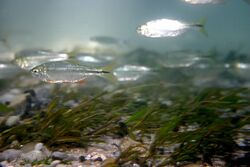Biology:Astyanax (fish)
| Astyanax | |
|---|---|

| |
| Astyanax mexicanus | |
| Scientific classification Error creating thumbnail: Unable to save thumbnail to destination
| |
| Domain: | Eukaryota |
| Kingdom: | Animalia |
| Phylum: | Chordata |
| Class: | Actinopterygii |
| Order: | Characiformes |
| Family: | Characidae |
| Subfamily: | incertae sedis |
| Genus: | Astyanax S. F. Baird & Girard, 1854 |
| Type species | |
| Astyanax argentatus Baird & Girard, 1854
| |
| Synonyms | |
|
Anoptichthys Hubbs & Innes, 1936 | |
Astyanax is a genus of freshwater fish in the family Characidae of the order Characiformes. Some of these fish, like many of their relatives, are kept as aquarium pets and known collectively as tetras. With around 150 described species and new ones being described yearly,[2] this genus is among the largest of the entire order; Hyphessobrycon also has more than 145 species and which one is larger at any one time depends on whether more species have been recently described in one or the other. The blind and colorless cave tetra of Mexico is a famous member of the genus, but its taxonomic position is disputed: Some recognize it as part of the Mexican tetra (A. mexicanus) and this is supported by phylogenetic evidence,[3][4][5][6][7] but others recognize the cave form as a separate species, A. jordani.[2]
The type species is A. argentatus, now regarded as a form of the Mexican tetra (A. mexicanus). The generic name comes from Astyanax, a character in Greek mythology, who was the son of Hector of Troy; in homage to this, several specific epithets also refer to the Iliad.[2]
Taxonomy and systematics
This genus is more or less defined as in 1917 by Carl H. Eigenmann. The lack of comprehensive phylogenetic analyses dealing with this genus is hindering a thorough review and the relationships remain as indeterminate as the monophyly is doubtful. The results of 2020 study using a combination of molecular and morphological data appeared to confirm that Astyanax is not monophyletic and suggested the creation of two new genera and the resurrection of Psalidodon.[8] Although included in Astyanax by FishBase, phylogenetic evidence supports moving A. aurocaudatus back to the monotypic genus Carlastyanax.[9]
Species
There are currently 124 recognized species in this genus:
References
- ↑ 1.0 1.1 1.2 1.3 1.4 1.5 Schmitter-Soto, Juan J. (2016). "A phylogeny of Astyanax (Characiformes: Characidae) in Central and North America". Zootaxa 4109 (2): 101–130. doi:10.11646/zootaxa.4109.2.1. PMID 27394856.
- ↑ 2.0 2.1 2.2 Froese, Rainer and Pauly, Daniel, eds. (2016). Species of Astyanax in FishBase. October 2016 version.
- ↑ Jeffery W (2009). "Regressive evolution in Astyanax cavefish". Annu. Rev. Genet. 43: 25–47. doi:10.1146/annurev-genet-102108-134216. PMID 19640230.
- ↑ "Evidence for multiple genetic forms with similar eyeless phenotypes in the blind cavefish, Astyanax mexicanus". Mol. Biol. Evol. 19 (4): 446–455. 2002. doi:10.1093/oxfordjournals.molbev.a004100. PMID 11919286.
- ↑ Bradic, Martina; Beerli, Peter; García-de León, Francisco J; Esquivel-Bobadilla, Sarai; Borowsky, Richard L (2012). "Gene flow and population structure in the Mexican blind cavefish complex (Astyanax mexicanus)". BMC Evolutionary Biology 12 (1): 9. doi:10.1186/1471-2148-12-9. PMID 22269119.
- ↑ "Phylogeography of surface and cave Astyanax (Teleostei) from Central and North America based on cytochrome b sequence data". Mol. Phylogenet. Evol. 33 (2): 469–481. 2004. doi:10.1016/j.ympev.2004.07.001. PMID 15336680.
- ↑ Keene; Yoshizawa; McGaugh (2016). Biology and Evolution of the Mexican Cavefish. Elsevier Science. pp. 77–87. ISBN 978-0-12-802148-4.
- ↑ Guillermo E. Terán; Mauricio F. Benitez; J. Marcos Mirande (2020). "Opening the Trojan horse: phylogeny of Astyanax, two new genera and resurrection of Psalidodon (Teleostei: Characidae)". Zoological Journal of the Linnean Society 190 (4): 1217–1234. doi:10.1093/zoolinnean/zlaa019.
- ↑ "Phylogenetic relationships of the enigmatic Carlastyanax aurocaudatus (Eigenmann) with remarks on the phylogeny of the Stevardiinae (Teleostei: Characidae)". Neotropical Ichthyology 11 (4): 747–766. 2013. doi:10.1590/s1679-62252013000400003.
- ↑ 10.0 10.1 "Review of species of the Astyanax bimaculatus "caudal peduncle spot" subgroup sensu Garutti & Langeani (Characiformes, Characidae) from the rio La Plata and rio São Francisco drainages and coastal systems of southern Brazil and Uruguay". Zootaxa 4072 (1): 101–125. 2016. doi:10.11646/zootaxa.4072.1.5. PMID 27395912.
- ↑ "A new species of Astyanax Baird & Girard (Ostariophysi: Characidae) from the rio Taquari-Antas basin, southern Brazil". Neotropical Ichthyology 13 (2): 265–272. 2015. doi:10.1590/1982-0224-20140145. http://www.scielo.br/pdf/ni/2015nahead/1982-0224-ni-20140145.pdf.
- ↑ 12.0 12.1 12.2 12.3 Garavello, J.C.; Sampaio, F.A.A. (2010). "Five new species of genus Astyanax Baird & Girard, 1854 from Rio Iguaçu, Paraná, Brazil (Ostariophysi, Characiformes, Characidae)". Brazilian Journal of Biology 70 (3): 847–865. doi:10.1590/s1519-69842010000400016. PMID 21085790. http://www.scielo.br/pdf/bjb/v70n3s0/16.pdf.
- ↑ Bertaco, V.A. (2014). "Astyanax douradilho, a new characid fish from the rio Tramandaí system, southern Brazil (Characiformes: Characidae)". Zootaxa 3794 (3): 492–500. doi:10.11646/zootaxa.3794.3.10. PMID 24870337. http://www.onganama.org.br/atualizacoes/2014/10.outubro2014/Astyanax%20douradilho%20Bertaco%202014.pdf. Retrieved 2016-07-25.
- ↑ Ingenito, L.F.S.; Duboc, L.F. (2014). "A new species of Astyanax (Ostariophysi: Characiformes: Characidae) from the upper rio Iguaçu basin, southern Brazil". Neotropical Ichthyology 12 (2): 281–290. doi:10.1590/1982-0224-20130117.
- ↑ "Astyanax guaricana (Ostariophysi: Characidae), a new species from the rio Cubatão drainage, Paraná State, Southern Brazil". Neotropical Ichthyology 11 (2): 291–296. 2013. doi:10.1590/s1679-62252013000200007.
- ↑ "Redescription of Astyanax novae Eigenmann, 1911 (Teleostei: Characidae)". Ichthyological Exploration of Freshwaters 26 (2): 183–192. 2015.
- ↑ "A new species of Astyanax from headwater streams of southern Brazil (Characiformes: Characidae)". Zootaxa 3700 (2): 226–236. 2013. doi:10.11646/zootaxa.3700.2.2. PMID 26106724.
- ↑ "Astyanax pirapuan: a new characid species from the upper Rio Paraguay system, Mato Grosso, Central Brazil (Characiformes, Characidae)". Zootaxa 2749: 40–46. 2011. doi:10.11646/zootaxa.2749.1.3. http://www.mapress.com/zootaxa/2011/f/z02749p046f.pdf.
- ↑ "Three new species of Astyanax from drainages of southern Brazil (Characiformes: Characidae)". Neotropical Ichthyology 11 (3): 537–552. 2013. doi:10.1590/s1679-62252013000300007.
Wikidata ☰ Q312315 entry
 |

